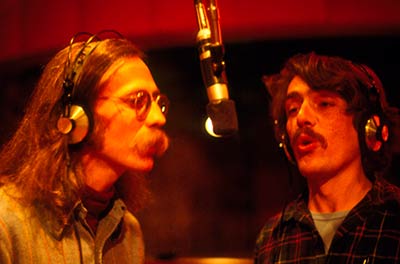Sing Sailor (1977)
Author: Robert Force
Date/Studio: 1977 Biscuit City, Denver, CO
Engineer: N.C. Bull
Producer: Laura Benson
Original Release: Pacific Rim Dulcimer Project (BC1314
Current Release: The Complete Recordings (BSR 158)
 Three versions of this tune were recorded. I did it solo on the Pacific Rim Dulcimer Project (1977). Al adds his dulcimer along with Tim Celeski's chimes and Denny Goodhew's flute on the Crossover version. Al and I did it as an instrumental duet on Wellyn. In Germany, we performed this song with Roberto Detreé and Gruppe Between. Roberto's classical guitar provided arpeggios that had the feel of a ship slowly climbing a wave, falling off, rolling to the side, splashing into the trough.
Three versions of this tune were recorded. I did it solo on the Pacific Rim Dulcimer Project (1977). Al adds his dulcimer along with Tim Celeski's chimes and Denny Goodhew's flute on the Crossover version. Al and I did it as an instrumental duet on Wellyn. In Germany, we performed this song with Roberto Detreé and Gruppe Between. Roberto's classical guitar provided arpeggios that had the feel of a ship slowly climbing a wave, falling off, rolling to the side, splashing into the trough.
I wrote the melody for this song the on same day that I got my first dulcimer in August of 1968, ten days before my 20th birthday. I stayed up all night and wrote three songs. The magic of the instrument had captivated me completely. I had no idea how to tune it or hold it or certainly, play it. Didn't matter. It was in my hands! There were songs in my head that I didn't even know were there until then.
I fumbled my way into the truth of folk music. The Sing Sailor tune is built on having discovered the dominant relationship in music: do-sol-do. With the discovery of music also came the discovery of a powerful tool for examining the world. I could objectify in song what I thought about something. I never thought about it being good songwriting or even poetry. I really couldn't sing. I wasn't a natural. But I was a thinker. Couched in musical phrases I could hang my thoughts outside of myself.
One verse of that evening did shape what Sing Sailor was later to become. “And I am a sailor, gone for so long upon these wide waters that now still my song.” I had always been a seeker-- someone who wanted to know the relationship between person and spirit. What I was writing about (examining / postulating) was reincarnation-- sort of a Where Have All the Flowers Gone theme that ended with me “being a young man with memories to gain, traveling quickly over where once I was laid.”
Urk. Holy Moly! Heavy stuff. (And bad poetry!) It didn't matter. That song could never be more than my jumping off place into music. Hanging it out in the air for me to poke and examine was a way to tell myself, “Enough, already. Get on with it!” Besides, being a bad poet didn't mean I didn't know what good poetry should be. I was content to let a lifetime of exploration take care of that process.
On the road three years later I met the person who was to become my musical partner for nearly 20 years, Albert d'Ossché, at the 44th Annual Union Grove Fiddler's Convention in North Carolina. It was Easter Sunday, 1971. We struck up a friendship and he invited me to his place in Washington DC.
I showed up a couple of months later. He lived in the Adams Morgan neighborhood of DC on Biltmore Street where Rock Creek Park was crossed by the Calvert Street (now Louis Armstrong) bridge. His landlords, John and Sue, readily made room for me. Al was a photographer and went off to work. I was an itinerant musician who sat on people's front porches and played music.
The simple melody came back and the Sing Sailor words were written on their front stoop. I was on a journey so I could easily write about someone else being on a journey. I was looking for love. I could write about someone who had found that and then had to leave. I wanted someone to pine for me, so I could write about that, too. The wind, as a dragon and as a song, the stars being lanterns guiding me-- all fitting metaphors for a young man out in the world, discovering himself and hoping to find love.
And the song worked. It went beyond what I thought it was and reached into that shared space between our lives and someone else's. The universal sentiments and simple melody left room for others to “own” the tune, for it to also be their story. I still sing it. It's also timeless for me.
